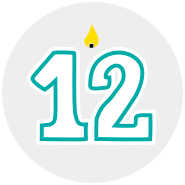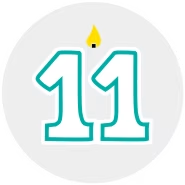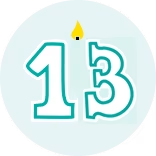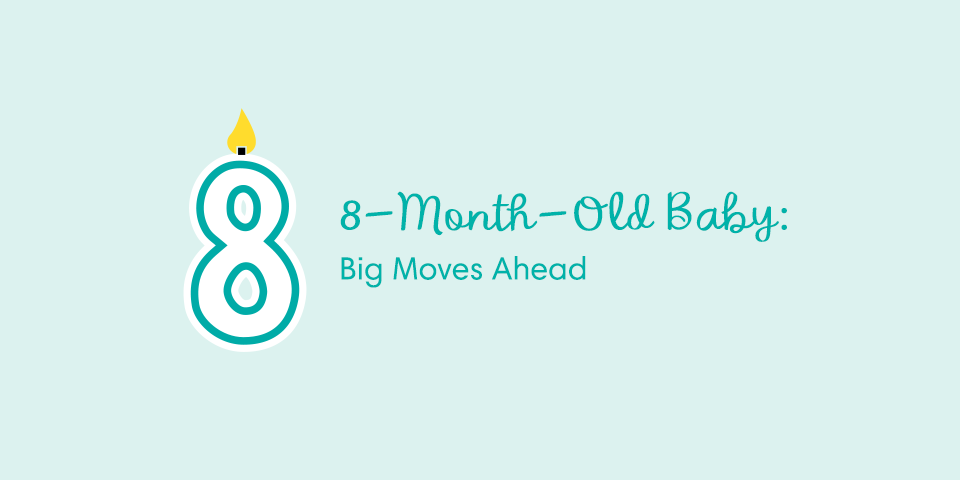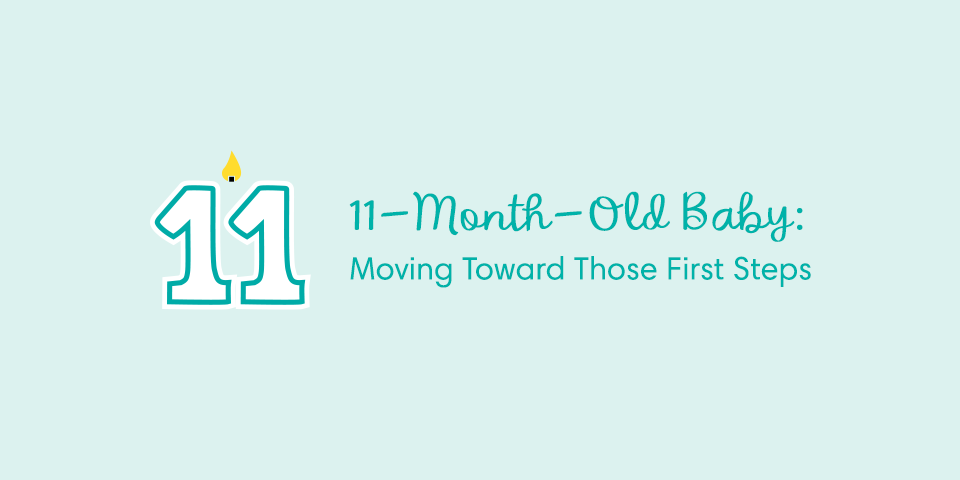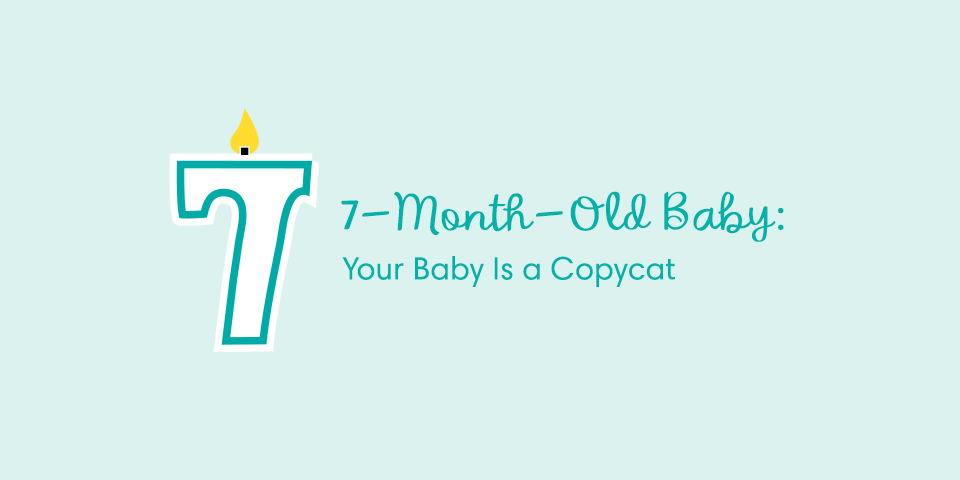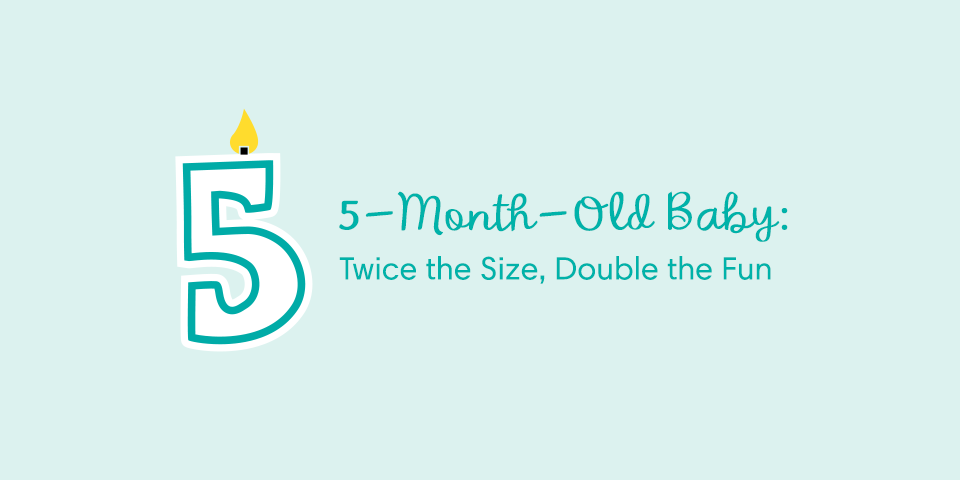12-Month-Old Baby: Your 1-Year-Old’s First Birthday!
Can you believe it’s been a year? Your little one has reached the 12-month mark and has a lot to show for it! They’re becoming more capable of feeding themselves and expressing themselves, and, if they haven’t done so already, they’re gearing up to take those all-important first steps. At this point, their diet may change slightly, and sleeping through the night may be a challenge now and then, but they’re growing and learning every day. Learn more about the various milestones and development stages on the horizon for you and your 1-year-old baby this month.
Baby Development Milestones
Get ready for a wave of 12-month-old baby development milestones and activity, which could include your baby’s first words and first steps right around now or sometime soon. Your on-the-go little one is gaining confidence and independence along with their new mobility, whether they’re crawling, scooting, cruising (walking while holding on to furniture for support), or walking already. Your 12-month-oldmay also be working on speech milestones as they start to form the sounds and syllables that will eventually become words.
Growth and Physical Development: Keep Watching Them Grow
Your baby’s done a lot of growing in the last 12 months! In fact, by their first birthday, it’s possible that they may stand at an impressive 28 to 32 inches tall and may have tripled their birth weight. If you're wondering how much “should” a 12-month-old weigh, there's no single ideal weight, as every baby is different. When your baby's growth is plotted on a chart, your baby may be above or below average weight, but that doesn’t mean anything’s wrong—these are just statistics.
Know that babies’ growth tends to slow down around their first birthday, and that you can always check the growth charts that your baby’s healthcare provider uses to make sure your baby is progressing as expected.
As your little one starts taking their first few tentative steps, you may notice their feet are turned outward. This is normal and should correct itself naturally. Over time, the ligaments of their hips will tighten, and their feet will start to point forward.
Dental hygiene is important at this time, too. Experts advise that you make your baby’s first dental appointment when their first tooth comes in, but certainly by their first birthday. Once those first teeth start appearing, make sure to brush them gently twice a day, and focus on weaning your baby off the bottle around their first birthday to help prevent tooth decay. There’s a lot of variation among babies as to when their first teeth start to appear, so don’t worry so much about how many teeth they may or may not have at this point and focus more on oral hygiene.
Senses: Bright-eyed and Curious
By now, your 12-month-old baby’s vision is sharper than ever. They can now see just as clearly as you can and are able to identify a familiar face from 20 feet away! You may notice that their hand-eye coordination is improving, too. At 1 year old, their vision and fine motor skills may now allow them to reach for and pick up specific objects and even feed themselves with greater control.
Your baby may be more able to focus on small details at this point and may be able to handle small pieces of food more easily. It’s also likely that more food is ending up in their mouth than on the floor as they become more skilled at guiding finger foods or maybe a spoon to their mouth and using a sippy cup.
Movement: Cruising and Balancing
Those first wobbly steps are among the more exciting milestones your 12-month-old baby may be accomplishing around this time, or in the next few months. By this age, your little one may be a pro at pulling themselves into a standing position and even taking steps while holding onto furniture (known as cruising).
Your child's balance is improving, and you may see them let go of the furniture or your hands and take two or three steps on their own, without support. They’ll lose balance and drop to the floor from time to time, and that's all part of the learning process. Just make sure you’ve provided a safe space for these early falls. Most babies only stumble for a short time before finding their footing and walking with confidence.
Cognitive Development: Practicing Sounds and Words
By now, your baby can imitate gestures and point or crawl toward something they want. They’re also working hard on getting to the point where they’ll be able to communicate what they’d like with basic words, such as by experimenting with sounds. You may find they’re able to make some recognizable syllables like “ma,” “ga,” or “ba.”
These are all stepping-stones toward their first real words. You may be eagerly awaiting what their first word will be, but keep in mind all babies are different and start speaking at different times. Keep talking and reading to them, and you’ll inspire them to practice more sounds and eventually try to communicate with you.
Activities for Supporting Your 1-Year-Old Baby’s Development
Your daily activities offer many opportunities to help stimulate your 12-month-old baby’s curiosity and nurture their development. Talk to your baby as you go about your day and spend time playing and reading together, too. Create and consistently follow routines for bedtime, mealtime, and playtime. For example, if your 1-year-old enjoys a bedtime story or dedicated playtime on the floor, include these activities as part of their daily routine at home. If a caregiver is spending time with your baby, ask them to follow your family’s routines, too.
So, what should a 1-year-old be doing? Playing is a start! Play is fun and gives your baby an opportunity to work on important skills. Here are a few ideas to keep in mind:
Feeding Your 12-Month-Old Baby
If you’re wondering what to feed your 1-year-old, take a look at your own plate for inspiration, as any healthful foods you and the rest of the family are eating could be added to your baby’s diet. You may notice that your 12-month-old is less interested in baby foods and more interested in what’s happening and being served at the family dinner table.
Aim to offer foods with different flavors and textures, and share some of your meals, whether that’s small bites of steamed veggies or pieces of pasta. Just make sure any adult food is unseasoned (babies don’t need spices or salt) and mashed or cut into pieces to prevent choking. It's likely that your baby’s getting better at handling finger foods and feeding themselves, making mealtimes a bit less messy.
If your baby doesn’t seem particularly excited about a new food, keep in mind it can take as many as 10 to 15 attempts before a child can truly decide whether they like a certain food or flavor. You might think of this as picky eating but remember that your baby is experiencing some of these foods for the first time, and there’s bound to be a few they don’t like. That doesn’t mean you can’t try it with them again.
If you’re wondering how much a 1-year-old “should” eat, this can vary. Aim to provide your baby with three meals and two snacks each day. Keep in mind that one day your baby may have a ravenous appetite and eat all the meals you give them, but on any other given day they may turn away meals. This inconsistency can depend on their activity levels and metabolism. So, don’t expect your 12-month-old to always keep to the feeding schedule you’ve planned for them. Ideally, around 1,000 calories per day will meet your baby’s needs for healthy growth and development.
Introducing Your Baby to Cow’s Milk
After your baby turns 1 year old, you can start to introduce to cow’s milk—either whole milk or reduced fat (2 percent) milk—and phase out formula. You can, however, continue to breastfeed on demand if your baby wants to do so.
Start offering cow’s milk gradually, serving it in a cup, working up to around 2 cups of milk (16 ounces) each day or less.
If you notice any symptoms like hives, wheezing, vomiting, or diarrhea within hours or days of your baby’s first taste of cow’s milk, contact your baby’s healthcare provider, who may conduct some tests to determine if your baby has a milk allergy.
How New Foods May Change Your Baby’s Poop
Now that your baby is enjoying a wider variety of foods, including cow’s milk, you may notice changes in the frequency and consistency of their poop. Keep an eye out for diarrhea and also for signs of constipation, such as hard stools or your baby seeming distressed when having a bowel movement.
If you haven’t already, now is a great time to sign up for Pampers Rewards app. Earn Pampers Cash from all your purchases of Pampers diapers and redeem for discounts at one of your favorite retailers.
How Much Sleep Does a 12-Month-Old Baby Need?
And how many naps? At 1 year old, your baby will need between 12 and 16 hours of sleep each day, including 2 daytime naps that can last between 30 minutes and 2 hours each. With any luck, your baby will be sleeping for longer stretches at night, even if they are waking and crying from time to time. Since every baby is different, your 1-year-old baby’s sleep schedule may differ from these averages.
To learn more about your baby’s sleep, download the Smart Sleep Coach app by Pampers. Cocreated by pediatricians and sleep experts, this easy-to-use app can help you establish your baby’s sleep schedule and tackle sleeping difficulties as they arise.
To help you both get through the more challenging nights, here are a few tips for sleep success:
A Day in the Life of Your 12-Month-Old Baby
Wondering what to do with a 1-year-old? Each baby and every family is different, but here’s a sample schedule that could be followed with a 1-year-old in the house.
Your Baby’s Health
From chronic conditions to temporary bouts of indigestion, there are a variety of health problems that could affect your baby. Your 1-year-old may struggle digesting some of the new foods they’re eating, and may also develop some reactions to their environment, like sneezing or other allergy-like symptoms. The following are a few conditions to watch for:
Development Tips for Your Baby This Month
This month, consider the following to help promote your 12-month-old baby’s development:
Items You Will Need This Month
Here’s a list of baby gear items you may like to purchase this month if you haven’t already:
FAQS AT A GLANCE
Each baby is different. At 12 months, your baby may or may not be walking, and either scenario is normal. They’re likely to become a pro at pulling themselves into a standing position, and they may have taken to cruising around the room while holding onto furniture for support. They may take some tentative steps unassisted around this time and will get better as their balance improves.
Your Life as a Parent: Creating Lasting Memories
You likely have an array of photos of your little one on your phone, but have you considered turning those snapshots into a more lasting memory? Consider making a scrapbook, photo book, memory box, or other keepsake to help you document and remember your baby’s first year.
Maybe you’ve kept your baby’s hospital ID bracelet from when they were born, or you’ve been hanging onto a lock of hair from that very first haircut. Unique keepsakes like this are ideal to include in the memory book or box. Don’t forget to add pictures of yourself and other family members from their time together with your baby.
First Birthday Fun
Gearing up for your little one’s first birthday bash? It’s an exciting milestone, and you’ll certainly want to celebrate with your loved ones. One way to start the planning is by choosing a theme. You can go with a seasonal theme, such as a garden party for your spring baby, or a fall festival for your autumn-born baby.
Another idea is to plan your party around animals, cars, or anything else that catches your baby’s attention. Once you have a theme in mind, it will make choosing invitations and decorations a bit easier.
Next, consider your guest list: Will you keep it intimate and invite just close relatives and friends? Or will you plan a bigger party with neighbors, coworkers, and all their families, too? It’s up to you what you choose, but the most important thing is to snap lots of photos, enjoy the day, and celebrate how far you’ve come as a parent and as a family!
Checklist for This Month
□ Shop for shoes. If your little one’s walking or cruising outside, it’s probably time for their first pair of shoes! Make sure the ones you select are made of a flexible material, have nonskid soles, and have room for growth. It’s a good idea to have this first pair fitted by a professional to make sure you get the right size.
□ Schedule your baby’s 12-month checkup. At this important visit, your baby will get their latest round of immunizations, and their healthcare provider will evaluate your baby’s overall health and development.
□ Take the opportunity to ask questions and get advice if you need it. There's so much going on in terms of your baby's development at the 1-year mark, and your provider is a wonderful resource for information and general guidance. Feel free to bring up anything that's on your mind, such as
□ Make an appointment for a dental checkup. If you haven’t already, go ahead and schedule your baby’s first trip to the dentist.
For even more information, sign up to get our regular emails:
How We Wrote This Article The information in this article is based on the expert advice found in trusted medical and government sources, such as the American Academy of Pediatrics and the American College of Obstetricians and Gynecologists. You can find a full list of sources used for this article below. The content on this page should not replace professional medical advice. Always consult medical professionals for full diagnosis and treatment.
- American Academy of Pediatrics. Caring for Your Baby and Young Child: Birth to Age 5, 7th ed. (New York: Bantam Books, 2019).
- healthychildren.org. “AAP Schedule of Well-Child Care Visits.”
- healthychildren.org. “Baby’s First Tooth: 7 Facts Parents Should Know.”
- healthychildren.org. “Cow’s Milk Alternatives: Parent FAQs.”
- healthychildren.org. “Feeding & Nutrition Tips: Your 1-Year-Old.”
- healthychildren.org. “Infant Vision Development: What Can Babies See?”
- healthychildren.org. “Movement: 8 to 12 Months.”
- healthychildren.org. “Why Do Infants Need Baby Formula Instead of Cow's Milk?”
- KidsHealth. “Feeding Your 8- to 12-Month-Old.”
- KidsHealth. “Formula Feeding FAQs: Starting Solids and Milk.”
- KidsHealth. “Milk Allergy in Infants.”
- KidsHealth. “Nutrition Guides for Toddlers.”
- KidsHealth. “Questions & Answers—How Can I Tell if My Baby Is Constipated?”
- KidsHealth. “Sleep and Your 1- to 2-Year-Old.”
- KidsHealth. “Sleep and Your 8- to 12-Month-Old.”
- KidsHealth. “Your Baby's Hearing, Vision, and Other Senses: 12 Months.”
- KidsHealth. “Your Child's Checkup: 1 Year (12 Months).”
- National Library of Medicine. “Early Taste Experiences and Later Food Choices.”
- National Library of Medicine. “Weaning From the Breast.”
- PR Newswire. “American Academy of Pediatric Dentistry Encourages Parents to 'Get it Done in Year One' for a Lifetime of Healthy Smiles.”
